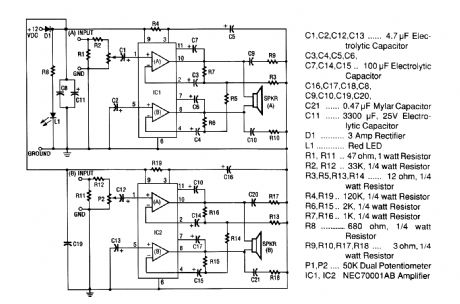Amplifier Circuit
20_W___20_W_STEREO_AMPLIFIER
Published:2009/6/15 21:26:00 Author:May | From:SeekIC

The 20-W + 20-W stereo amp consists of two complete, separate 20-W RMS bridge-type ampli-fiers. The input signal source is brought into the amplifier through the voltage divider network, which is made up of R1, R2, and P1. Resistor R1 provides a load impedance between the signal source and ground. Resistor R2 couples that signal to potentiometer P1.The signal is coupled by capacitor C1 to the noninverting (+) input (pin 1) of intemal amplifier (A) of IC1, where the signal is greatly amplified. Capacitor C2 couples the (+) input of the other (B) internal amplifier of IC1 to ground. That causes the input signal, which is referenced to ground, to be coupled to both amplifiers because both the inputs and outputs of IC 1 (A) and IC 1 (B) are connected in a bridge configuration. Notice that the output of IC1 (A) from pin 10 is connected to one side of the speaker and the output of IC1 (B) from pin 8 is connected to the other side of the speaker. That is why the speakers used cannot have one side connected to ground. Resistors R6 and R7 set the gain of the amplifier. Resistors R9 and R10 and capacitors C9 and C10 provide frequency stability ancl pre-vent oscillation. Capacitors C6 and C7 provide bootstrapping, which prevents distortion at low fre-quencies. LED L1 lights up by way of a series resistor connected from the anode to +12 Vdc when power is applied.Power for both IC1 and IC2 is brought in through D1 (to protect amplifiers from reverse polar-ity). Capacitor C11 provides additional power supply line filtering. This booster is capable of pro-ducing 20 W RMS output out of each channel.
Reprinted Url Of This Article:
http://www.seekic.com/circuit_diagram/Amplifier_Circuit/20_W___20_W_STEREO_AMPLIFIER.html
Print this Page | Comments | Reading(3)

Article Categories
power supply circuit
Amplifier Circuit
Basic Circuit
LED and Light Circuit
Sensor Circuit
Signal Processing
Electrical Equipment Circuit
Control Circuit
Remote Control Circuit
A/D-D/A Converter Circuit
Audio Circuit
Measuring and Test Circuit
Communication Circuit
Computer-Related Circuit
555 Circuit
Automotive Circuit
Repairing Circuit
Code: